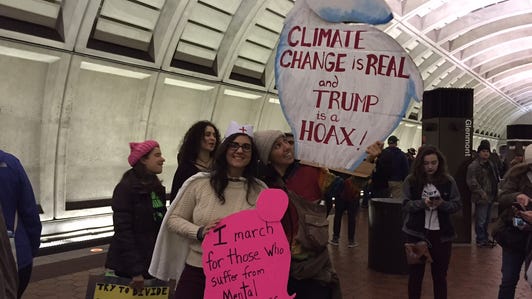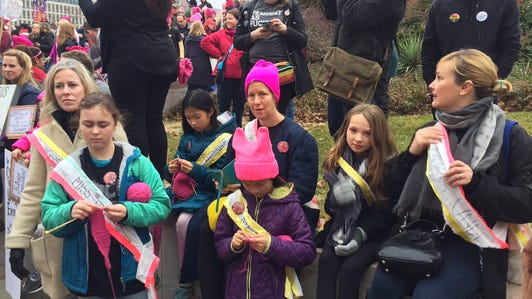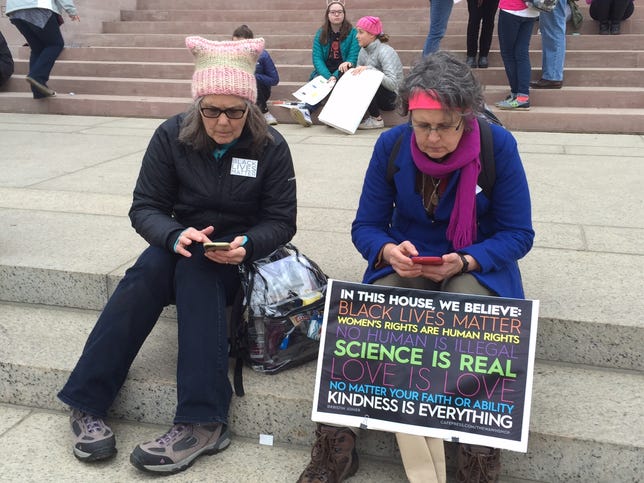The idea for the Women’s March on Washington to protest Donald Trump’s presidency started as a Facebook post, but for anyone actually at the march on Saturday, sharing their experience on social media during the event was nearly impossible.
The wireless networks ground to a halt for much of Saturday as hundreds of thousands of people marched in Washington DC to show the new president they intend to challenge his policies for the next four years.
I was there just four blocks from the rally’s main stage on Independence Ave. By 10 a.m. when the rally began, social media sites like Facebook, Twitter and Instagram were unreachable. And it was even difficult to send and receive text messages.
Forget about live-streaming speeches from feminist icon Gloria Steinem or liberal filmmaker Michael Moore, who implored marchers to flood their congressional representatives with phone calls everyday. And even Madonna’s confrontational R-rated rant likely wasn’t streaming live from anyone’s phone as it happened.
The network was simply unavailable until early afternoon when the march finally got under way and people began dispersing. Even then, uploading pictures or video was spotty at best. But at least text messages could be sent and received.


Michael Moore tells protesters at the Women’s March to get involved in the political process and to flood their Congressional representatives with phone calls.
CNET/Marguerite Reardon
Network issues should come as little surprise to spectators at any big public gathering. As wireless customers, we’ve come to expect it. But considering that all four major wireless carriers — AT&T, Verizon, Sprint and T-Mobile — told me that they spent the past two years and millions of dollars preparing for the inauguration, you’d think the networks would hold up better.
After all, Verizon said it had increased its wireless data capacity by 500 percent on the National Mall and throughout the city. AT&T said it spent $15 million over the past two years to increase its 4G LTE capacity by 400 percent. And yet on Friday spectators at the inauguration, which I also attended, likewise couldn’t get internet access to post photos and video to social media like Instagram or Twitter. Phone calls were dropped and text messages didn’t get sent.
Crowds flood the city
Maybe I’m being a bit harsh in my judgment of the wireless carriers. The crowds for both the Trump inauguration and the Women’s March were big, although official numbers haven’t been released. Planners for the inauguration were expecting between 800,000 to 900,000 people. Most experts agree the number is likely far less smaller, in spite of Trump’s protests that the media have been showing misleading aerial photographs of the crowd. By contrast, the Women’s March was permitted for only 200,000 attendees and organizers say that at least 500,000 people showed up with much of the crowd spilling onto the National Mall.
These numbers are huge when it comes to providing mobile service, especially when you consider most NFL stadiums hold about 80,000 fans for a big game like the Super Bowl.
The Women’s March on Washington






+15 more
The ‘sharing’ culture
What’s more, mobile devices have become extensions of ourselves as we all feel the need to share our experiences online. Almost every moment of the 2016 election was tweeted on Twitter, shared on Instagram or discussed on Facebook. We now have a president whose primary form of communicating with the world is through two Twitter accounts — his own, with nearly 21 million followers, and @POTUS, which switched to Trump on Friday and had over 5 million followers by midday.
“It’s about sharing the experience and wanting to let people know they are part of the experience,” said Marcia DiStaso, an associate professor of public relations and social media at Penn State University. “It’s the check-in mentality. We care more about people hearing us as a collective than individually.”


Two women finally got access to the internet as they sit on the steps of the Smithsonian’s National Art Gallery after the Women’s March in Washington.
CNET/Marguerite Reardon
The carriers acknowledge that the loads on their network were high both for Friday’s inauguration and for the protest that followed.
Sprint said it saw on Saturday “unprecedented traffic levels in DC and in other cities, far outpacing historically large data events such as the Super Bowl.” It’s still gathering statistics on exact usage on its network on Saturday. But the company said it saw a total of 6.2 terabytes of data traverse its network from midnight on Friday until 6 p.m.
AT&T and Verizon, which each have more than double the number of customers that Sprint has, reported similarly high levels of network usage. AT&T told me its customers used more than 4.5 terabytes of data during the inauguration ceremony Friday morning, compared with 527 gigabytes of data for the entire day of Barack Obama’s inauguration in 2013. In comparison, AT&T customers used more than 5.2 TB of data at last year’s Super Bowl.
AT&T was unavailable for comment regarding its stats for Saturday.
Verizon said its customers used about 7 terabytes of data during Trump’s inauguration on Friday. About 67 percent of data use was dedicated to web browsing and social media, with Facebook and Snapchat being the most-used social apps for Verizon customers.
As for Saturday, Verizon didn’t have any hard figures to share, but a company spokesman acknowledged the “massive turnout in several cities” for the march, stating that it handled between two times and nine times the traffic of a normal weekend.
T-Mobile did not respond to a request for comment.
In spite of the near social media blackout, everyone around me continued shooting video on their phones and taking pictures of signs reading “Women’s rights are human rights,” “This sign is an object. I am NOT,” and my personal favorite, “Even wine can’t fix this.”
“I’ll just upload it later when I get a signal,” said the woman standing next me after asking me to take a picture of her in the foreground as CNN political commentator Van Jones appeared on the jumbo screen behind her. “This is probably the closest I’ll ever get to him.”
Solving for XX: The industry seeks to overcome outdated ideas about “women in tech.” Take a look here.
Technically Literate: Original works of short fiction with unique perspectives on tech, exclusively on CNET. Here.



